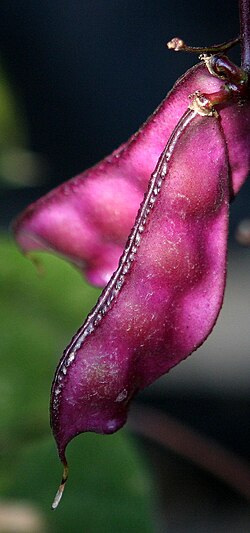Typical yield
2.1 t/ha
Varieties
3
Pest/Disease
6
Seasons
6
Profile
- Growth habit
- climber
- Lifecycle (days)
- 90–150
- Primary uses
- Pulse (dry seed); vegetable (green pods); forage/cover crop; green manure
- Pollination
- insect
- Origin / distribution
- Africa/Asia tropics; widely grown in East Africa (food & forage)
Environment
Climate
Temp optimal
20–30 °C
Rain optimal
600–900 mm/yr
Altitude
0–1800 m
Soil
pH optimal
6–7
Soil type
Well-drained loam/sandy loam; moderate fertility
Farmer Guide
Row spacing
75 cm
Plant spacing
45 cm
Depth
3 cm
Seed rate
25 kg/ha
Nursery days
Planting: Direct-seed at onset of rains on a fine seedbed. Provide stakes/trellis for vining types. Keep weed-free for first 4–6 weeks.
Transplanting: Transplant uncommon; if used, handle taproot gently.
Irrigation: Irrigate for establishment and during flowering/pod fill in dry spells.
Fertigation: Low N demand (N-fixing). If fertigating, use small N doses and adequate K.
Pest scouting: Scout for pod borers, aphids, beetles, and foliar diseases; remove infested pods and maintain hygiene.
Pruning/Training: Train vines on stakes/trellis; light tip-pinching can encourage branching.
Harvest: Pick green pods tender for vegetable use; for dry seed, harvest when pods turn brown and rattle.
Postharvest: Dry seed to ≤12% moisture; store cool and dry. For forage, cut at early flowering.
Nutrient Schedule
| # | Stage | DAP | Product | Rate | Targets (kg/ha) | Notes |
|---|---|---|---|---|---|---|
| 1 | Basal | 0 | NPK 17-17-17 (light) | 60 kg/ha | N: —, P₂O₅: —, K₂O: — | Or DAP 18-46-0 @ 50–60 kg/ha; inoculate seed where possible |
| 2 | Topdress (opt.) | 25 | CAN 26% N (light) | 30 kg/ha | N: —, P₂O₅: —, K₂O: — | Only if leaves pale and nodules absent/weak |
| 3 | K boost (opt.) | 40 | MOP (KCl) | 30 kg/ha | N: —, P₂O₅: —, K₂O: — | For intensive vegetable/forage use |
Nutrient Requirements
| Nutrient | Stage | Amount | Unit |
|---|---|---|---|
| P₂O₅ | Basal | 25 | kg/ha |
| K₂O | Basal | 20 | kg/ha |
| N | Topdress | 15 | kg/ha |
| K₂O | Flowering | 20 | kg/ha |
Images

| Name | Country | Maturity | Traits |
|---|---|---|---|
| Local Lablab | KE | 120 | Dual purpose |
| Rongai (forage type) | KE | 120 | Vigorous vine; high biomass; forage/cover |
| Local lablab (grain) | KE | 110 | Dual-purpose; edible dry seed |
| Stage | Product | Rate (kg/ha) | Notes |
|---|---|---|---|
| Basal | NPK 17-17-17 | 60 | At sowing; band or broadcast |
| Topdress | CAN 26% N (optional) | 30 | Only if poor nodulation |
| Flowering | MOP (KCl) (optional) | 30 | Support pod/leaf production |
| Name | Type | Symptoms | Management |
|---|---|---|---|
| Pod borer | pest | Bored pods | Timely picking; IPM |
| Pod borer (Maruca spp.) | pest | Bored pods; webbing; seed damage | Timely picking; sanitation; rotate actives if spraying |
| Aphids | pest | Curling; honeydew/sooty mold | Encourage natural enemies; soft sprays; control ants |
| Beetles/defoliators | pest | Leaf holes; defoliation | Scouting; spot treatments; hand-pick small outbreaks |
| Anthracnose/leaf spots | disease | Spots/lesions on leaves & pods | Rotation; airflow; protectants if severe |
| Powdery mildew | disease | White powdery growth on leaves | Spacing; sulfur or labeled fungicides |
| System | Typical | Min | Max | Notes |
|---|---|---|---|---|
| rainfed | 1.2 | 0.6 | 2 | |
| rainfed grain (dry seed) | 1.2 | 0.6 | 2 | Varies with support/management |
| forage biomass (dry matter) | 4 | 2.5 | 6 | Cut at early flowering |
| Country | Region | Planting | Harvest |
|---|---|---|---|
| KE | Western | Mar–Apr | Jul–Oct |
| KE | Western & mid-altitudes (long rains) | Mar–Apr | Jul–Oct |
| KE | Western & mid-altitudes (short rains) | Oct–Nov | Feb–Apr |
| UG | Central/Eastern (1st season) | Mar–Apr | Jul–Sep |
| UG | Central/Eastern (2nd season) | Aug–Sep | Dec–Feb |
| TZ | Northern unimodal | Nov–Dec | Mar–May |
| Country | Region | Suitability |
|---|---|---|
| KE | Arid/semi-arid w/out irrigation | Low |
| KE | Poorly drained wetlands | Low |
| KE | Western | High |
| KE | Western; Nyanza; mid-altitude humid | High |
| TZ | Northern & Lake zones | High |
| UG | Central & Eastern sub-humid | High |
